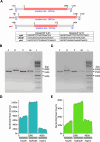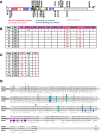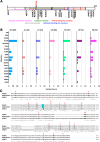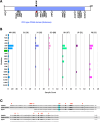Identification of genetic variations linked to buparvaquone resistance in Theileria annulata infecting dairy cattle in India
- PMID: 40679975
- PMCID: PMC12273908
- DOI: 10.1371/journal.pone.0326243
Identification of genetic variations linked to buparvaquone resistance in Theileria annulata infecting dairy cattle in India
Abstract
Buparvaquone (BPQ) is used for the treatment of bovine theileriosis, a tickborne disease caused by parasites of the Theileria genus. Studies on T. annulata have linked the mechanism of BPQ resistance predominantly to genetic variations in the parasite cytochrome b (cytb) gene. In addition, cryptic mechanisms of resistance involving the parasite peptidyl-prolyl isomerase (pin1) and dihydroorotate dehydrogenase (dhodh) genes require assessment. In India, where bovine theileriosis is endemic, and BPQ is widely used for treatment, it is necessary to establish the prevalence of genetic variations linked to BPQ resistance. In this study, multiplexed PCR amplification and nanopore sequencing method was used for genotyping the complete gene loci of the three target genes. Analysis of 454 T. annulata field samples collected from seven different states of India revealed the presence of previously reported BPQ resistance associated variations S129G, A146T and P253S in cytb gene and A53P in pin1 gene. The A146T and I203V variations in cytb were found to be prevalent and mostly co-occurring, and their role in BPQ resistance needs further evaluation. This study has revealed the presence of previously reported BPQ resistance-linked mutations in cytb and pin1 genes in T. annulata infecting dairy cattle in India and establishes an Oxford nanopore sequencing method suitable for large-scale surveillance of genetic variation in Theileria parasites from field samples.
Copyright: © 2025 Musale et al. This is an open access article distributed under the terms of the Creative Commons Attribution License, which permits unrestricted use, distribution, and reproduction in any medium, provided the original author and source are credited.
Conflict of interest statement
The authors have declared that no competing interests exist.
Figures




Similar articles
-
Systematic review on buparvaquone resistance associated with non-synonymous mutation in drug binding genes site of Theileria annulate.Vet Parasitol. 2024 Dec;332:110321. doi: 10.1016/j.vetpar.2024.110321. Epub 2024 Oct 9. Vet Parasitol. 2024. PMID: 39418760
-
SNP-based molecular diagnostic platform: rapid single-step identification of Theileria annulata and its buparvaquone-resistant strains.Parasit Vectors. 2025 Jul 1;18(1):247. doi: 10.1186/s13071-025-06884-y. Parasit Vectors. 2025. PMID: 40598565 Free PMC article.
-
Systematic proteomic and small RNA profiling of extracellular vesicles from cattle infected with a naturally occurring buparvaquone-resistant strain of Theileria annulata and from uninfected controls.Parasit Vectors. 2025 Jun 10;18(1):221. doi: 10.1186/s13071-025-06834-8. Parasit Vectors. 2025. PMID: 40495253 Free PMC article.
-
A Theileria annulata parasite with a single mutation, methionine 128 to isoleucine (M128I), in cytochrome B is resistant to buparvaquone.PLoS One. 2024 Apr 16;19(4):e0299002. doi: 10.1371/journal.pone.0299002. eCollection 2024. PLoS One. 2024. PMID: 38626086 Free PMC article.
-
Systematic Review and Meta-Analysis on Piroplasma spp. Infection and Co-infection with Anaplasma marginale in Domestic Ruminants from Algeria.Acta Parasitol. 2024 Mar;69(1):135-151. doi: 10.1007/s11686-023-00768-w. Epub 2023 Dec 29. Acta Parasitol. 2024. PMID: 38157135
References
-
- Gondard M, Cabezas-Cruz A, Charles RA, Vayssier-Taussat M, Albina E, Moutailler S. Ticks and Tick-Borne Pathogens of the Caribbean: Current Understanding and Future Directions for More Comprehensive Surveillance. Front Cell Infect Microbiol. 2017;7:490. doi: 10.3389/fcimb.2017.00490 - DOI - PMC - PubMed
-
- Zeb J, Song B, Aziz MU, Hussain S, Zarin R, Sparagano O. Diversity and Distribution of Theileria Species and Their Vectors in Ruminants from India, Pakistan and Bangladesh. Diversity. 2022;14(2):82. doi: 10.3390/d14020082 - DOI
MeSH terms
Substances
LinkOut - more resources
Full Text Sources
Miscellaneous

